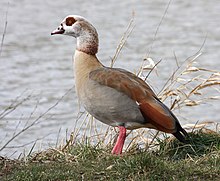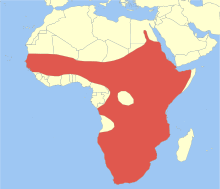Egyptian goose
| Egyptian goose | |
|---|---|

| |
| Scientific classification | |
| Domain: | Eukaryota |
| Kingdom: | Animalia |
| Phylum: | Chordata |
| Class: | Aves |
| Order: | Anseriformes |
| Family: | Anatidae |
| Genus: | Alopochen |
| Species: | A. aegyptiaca
|
| Binomial name | |
| Alopochen aegyptiaca (Linnaeus, 1766)
| |

| |
| Native range of A. aegyptiaca | |
| Synonyms | |
|
Anas aegyptiaca Linnaeus, 1766 | |
The Egyptian goose (Alopochen aegyptiaca) is a member of the duck, goose, and swan family Anatidae. It is native to Africa south of the Sahara and the Nile Valley.
Egyptian geese were considered sacred by the Ancient Egyptians, and appeared in much of their artwork. Because of their popularity chiefly as an ornamental bird, escapees are common and feral populations have become established in Western Europe, the United States, and New Zealand.[2]
Taxonomy
The Egyptian goose is believed to be most closely related to the shelducks (genus Tadorna) and their relatives, and is placed with them in the subfamily Tadorninae. It is the only extant member of the genus Alopochen, which also contains closely related prehistoric and recently extinct species. mtDNA cytochrome b sequence data suggest that the relationships of Alopochen to Tadorna need further investigation.[3]
Etymology
The generic name Alopochen (literally, fox-goose) is based on Greek ἀλωπός (alōpós, also ἀλώπηξ alōpēx), "fox", and χήν (chēn) "goose", referring to the ruddy colour of its back. The word χήν : chēn is grammatically of either masculine or feminine gender.
The species name aegyptiacus (or aegyptiaca) is from the Latin Aegyptiacus, "Egyptian".[4]
Description

It swims well and in flight looks heavy, more like a goose than a duck, hence the English name.[5] It is 63–73 cm (25–29 in) long.
The sexes of this species are identical in plumage but the males average slightly larger. There is a fair amount of variation in plumage tone, with some birds greyer and others browner, but this is not sex- or age-related. A large part of the wings of mature birds is white, but in repose the white is hidden by the wing coverts. When it is aroused, either in alarm or aggression, the white begins to show. In flight or when the wings are fully spread in aggression, the white is conspicuous.[6]
The voices and vocalisations of the sexes differ, the male having a hoarse, subdued duck-like quack which seldom sounds unless it is aroused. The male Egyptian goose attracts its mate with an elaborate, noisy courtship display that includes honking, neck stretching and feather displays.[7] The female has a far noisier raucous quack that frequently sounds in aggression and almost incessantly at the slightest disturbance when tending her young.[8]
Distribution
This species breeds widely in Africa except in deserts and dense forests, and is locally abundant. They are found mostly in the Nile Valley and south of the Sahara. While not breeding, it disperses somewhat, sometimes making longer migrations northwards into the arid regions of the Sahel.[6] It spread to Great Britain, Denmark, the Netherlands, Belgium, France, Germany and Italy where there are self-sustaining populations which are mostly derived from escaped ornamental birds.[9] Escapes have also bred on occasion in other places, such as Texas,[10][11] Florida,[10] California,[10] and New Zealand.[9]
The British population dates back to the 18th century, though only formally added to the British list in 1971.[12] In Great Britain, it is found mainly in East Anglia, and in various locations along the River Thames,[13][14] where it breeds at sites with open water, short grass and suitable nesting locations (either islands, holes in old trees or amongst epicormic shoots on old trees). During the winter, they are widely dispersed within river valleys, where they feed on short grass and cereals.[15][16] In the United Kingdom in 2009, it was officially declared a non-native species. Accordingly, Egyptian geese in Great Britain may be shot without special permission if they cause problems.[17]
In Europe, the species has been included since 2017 in the list of Invasive Alien Species of Union concern (the Union list).[18] This implies that this species cannot be imported, bred, transported, commercialized, used, exchanged or intentionally released into the environment and member states are obliged to try to eradicate the species.[19]
Behaviour
This is a largely terrestrial species, which will also perch readily on trees and buildings. Egyptian geese typically eat seeds, leaves, grasses and plant stems. Occasionally, they will eat locusts, worms, or other small animals. Until the goslings are a few weeks old and strong enough to graze, they feed largely on small aquatic invertebrates, especially freshwater plankton. As a result, if anoxic conditions lead to the production of botulinum toxin and it gets passed up the food chain via worms and insect larvae insensitive to the toxin, entire clutches of goslings feeding on such prey may die. The parents, who do not eat such organisms to any significant extent, generally remain unaffected.
Both sexes are aggressively territorial towards their own species when breeding and frequently pursue intruders into the air, attacking them in aerial "dogfights".[8] Egyptian geese have been observed attacking aerial objects such as drones that enter their habitat as well. Neighbouring pairs may even kill another's offspring for their own offsprings' survival, as well as for more resources.[20]
This species will nest in a large variety of situations, especially in holes in mature trees in parkland. The female builds the nest from reeds, leaves and grass and both parents take turns incubating the eggs.[7] Egyptian geese usually pair for life. Both the male and female care for the offspring until they are old enough to care for themselves.[20] Such parental care, however, does not include foraging for the young, who, being precocial, forage for themselves.
In their native range, predators of Egyptian geese include leopards,[21] lions, cheetahs, hyenas, crocodiles and Old World vultures.[22]
Gallery
-
Gosling
-
Goslings
-
Female from the front
-
Male (left) herding one of his females (right)
-
Immature birds
-
Subadult
-
In flight
-
Head
-
Front
-
Alopochen aegyptiacus eggs
-
Egyptian geese in Gauteng, South Africa
References
- ^ BirdLife International (2018). "Alopochen aegyptiaca". IUCN Red List of Threatened Species. 2018: e.T22679993A131910647. doi:10.2305/IUCN.UK.2018-2.RLTS.T22679993A131910647.en. Retrieved 11 November 2021.
- ^ Dohner, Janet V. (2001). The Encyclopedia of Historic and Endangered Livestock and Poultry Breeds. Yale University Press. ISBN 978-0300138139.
- ^ Sraml, M.; Christidis, L.; Easteal, S.; Horn, P.; Collet, C. (1996). "Molecular Relationships Within Australasian Waterfowl (Anseriformes)". Australian Journal of Zoology. 44 (1): 47–58. doi:10.1071/ZO9960047.
- ^ Jobling, James A (2010). The Helm Dictionary of Scientific Bird Names. London: Christopher Helm. pp. 33, 42. ISBN 978-1-4081-2501-4.
- ^ "What characteristics distinguish Egyptian Geese?". Archived from the original on 16 June 2013.
- ^ a b Madge, Steve; Burn, Hilary (1988). Waterfowl: An Identification Guide to the Ducks, Geese, and Swans of the World. Boston: Houghton Mifflin. pp. 170–171. ISBN 978-0-395-46727-5.
- ^ a b "Egyptian Goose Fact Sheet". Lincoln Park Zoo. Archived from the original on 19 July 2011.
- ^ a b MacLean, Gordon L.; Roberts, Austin (1988). Roberts Birds of Southern Africa. Hyperion Books. ISBN 978-1-85368-037-3.
- ^ a b Braun, D.G. (2004). "First documented nesting in the wild of Egyptian Geese in Florida" (PDF). Florida Field Naturalist. 32 (4): 138–143. Archived from the original (PDF) on 2016-03-04. Retrieved 2013-04-29.
- ^ a b c "Egyptian Goose". Audubon. 2017-11-14. Retrieved 2022-07-21.
- ^ Clark, Gary (2011-11-04). "Non-native Egyptian geese proliferating in Texas". Houston Chronicle. Retrieved 2020-05-22.
- ^ Holloway, Simon (2010). The Historical Atlas of Breeding Birds in Britain and Ireland 1875-1900. A & C Black. ISBN 9781408128664.
- ^ "Specieswatch: Egyptian goose". the Guardian. 2014-05-25. Retrieved 2021-04-29.
- ^ "Illuminated River's New Sacred Friends". Illuminated River. Retrieved 2021-04-29.
- ^ Sutherland, W. J.; Allport, G. (1991-07-01). "The distribution and ecology of naturalized Egyptian Geese Alopochen aegyptiacus in Britain". Bird Study. 38 (2): 128–134. doi:10.1080/00063659109477080. ISSN 0006-3657.
- ^ "Egyptian goose". RSPB. 13 December 2012. Retrieved 28 April 2013.
- ^ McCarthy, Michael (30 September 2009). "Britain's naturalised parrot now officially a pest". The Independent. London. Retrieved 1 May 2010.
- ^ "List of Invasive Alien Species of Union concern - Environment - European Commission". ec.europa.eu. Retrieved 2021-07-26.
- ^ "REGULATION (EU) No 1143/2014 of the European parliament and of the council of 22 October 2014 on the prevention and management of the introduction and spread of invasive alien species". Archived from the original on 2017-03-03.
- ^ a b "Egyptian Goose". Honolulu Zoo. Archived from the original on 2 April 2012.
- ^ "This goose feigns injury to save its chicks from a leopard". Animals. 2018-12-04. Retrieved 2022-04-03.
- ^ Tattan, Anna. "Alopochen aegyptiaca (Egyptian goose)". Animal Diversity Web. Retrieved 2022-04-02.
External links
- Egyptian Goose information from Birds of Britain
- Egyptian Goose photos from Go Birding
- Species text in The Atlas of Southern African Birds
- BirdLife species factsheet for Alopochen aegyptiaca
- "Alopochen aegyptiaca". Avibase.
- "Egyptian goose media". Internet Bird Collection.
- Egyptian goose photo gallery at VIREO (Drexel University)
- Interactive range map of Alopochen aegyptiaca at IUCN Red List maps
- Audio recordings of Egyptian goose on Xeno-canto.












